|
It's the Astronomy Online non-Blog, or un-Blog.
Everyone has a blog now and since I am no follower of trends, I decided to merge the blog with the website. And I don't want to neglect the website in favor of posting on the blog.
These are the pages that were on the blog of old:
- Home
- Archive (Index of Pages)
- Me
- Current Trends
- Links
- Soho Live
Links:
Google Maps - Mars
Google Maps - Moon
HiRISE
HiRISE - MRO Imaging
Mac Singularity
Meade4M
Slackerpedia Galactica
Software for the Mac
Starry Night Online
Venus Maps
More Favorites:


































Thank you for visiting!
|
|
 |
|
Imaging the Sun using a Coronado P.S.T and a Meade LPI:
I want to be ready for the Mercury transit that will occur this week, so I bought a special Solar telescope - the P.S.T. (Personal Solar Telescope) - made by Coronado Instruments. This particular telescope uses an affordable hydrogen-alpha filter (Ha). Using the Ha filter permits viewing of the Solar prominences, filaments, and granules which would otherwise be invisible using a standard solar filter. The P.S.T. is the most affordable Ha telescope available. My modest setup includes the P.S.T., the Meade LPI imager, K3CCDTools for image capture and initial processing and Adobe PhotoShop CS2. The telescope sits on a tripod.
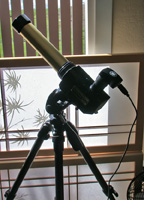
The Meade LPI imager was my second choice. Initially I purchased the latest Phillips Webcam SPC900NC through Adirondack Astronomy so I could get the included telescope adapter. What I discovered is because of the limited focus range on the P.S.T. and the depth of the CCD inside the SPC900NC, I could not get the image of the Sun to focus. The solution was the LPI - the chip is not as deep. As an aside, to install the telescope adapter on the SPC900NC, the lens ring (the focuser) pulls out - with some effort. Unscrew the lens and replace with the adapter.
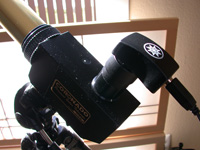
I installed the AutoStar suite that came with the LPI, but found the interface to be rather antiquated and lacking in features. I tried (and eventually purchased) K3CCDTools which provides a whole plethora of options - and I learned that this will control just about any webcam as long as the driver is installed. There are a many options to choose from and exploring the program on your own is the best way to learn. However, without knowing the program it is still possible to start imaging. First, make sure the drivers for your webcam are installed - in my case, I already installed the LPI software. Plug the camera into the USB port then open the K3CCDTools program. Under "device" select the appropriate camera:
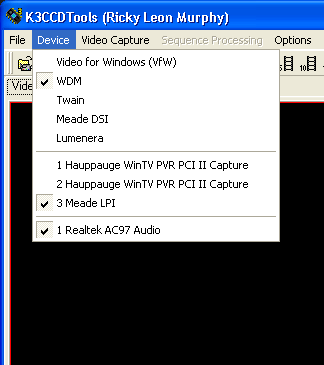
The "video properties" button, next to the camera icon, allows selection of the video size. The LPI is capable of 640 x 480 but choosing a smaller size allows for smoother viewing to facilitate focusing. Once focused, the video size can be increased:
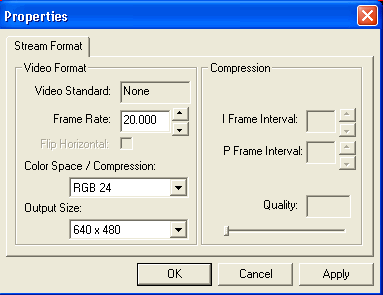
The "camera properties" button (a button with 3 sliders on it), which is next to the video properties button allows for changes to the shutter speed of the LPI. I imaged with both the automatic setting and a setting of 1/200th:
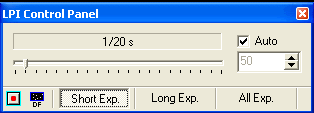
The button with the filmstrip and camera on it is the capture button. Click on the button to start capture and right-click on the button to stop capture. The videos are stored by default in the "My Documents" directory (this can be changed within the program).

Once the video is captured, it must be reopened to do any processing. Click the "open video" button and select the desired video (double-click), then click the "Sequence Processing" tab:
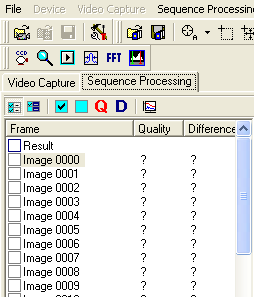
One or all of the images can be selected, then exported using the "export to bitmap" from the "file" menu. Bitmaps are the only option, but programs like PhotoShop can be used to save the image into any format you wish. The program allows for stacking of images, but I found this difficult to use for the Sun. I imagine stacking of planet images are much easier to do and I can't wait to try.
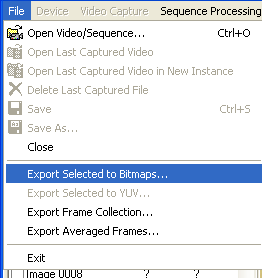
I selected on the of better frames from the video I captured and used PhotoShop CS2 to smart sharpen and removed noise.
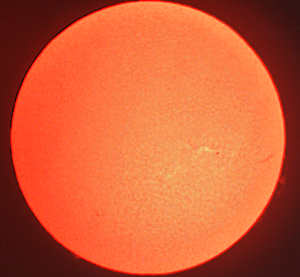
The above image is the "first light" from the LPI. First light simply means the first use of a camera. As you can see, the Sun in Ha is much more dramatic as you can see the prominences, granule and even a hint of a sunspot group - although a "standard" solar filter shows better sunspots.
Next Post | Previous Post | Back to Top
|
|

